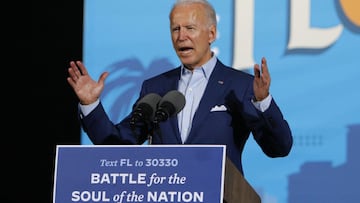What's Biden's plan for the economy, stimulus and unemployment?
The economic consequences of covid-19 will affect the US for years to come but what can Joe Biden offer Americans in need of financial support?


With just four days to go until Election Day 2020 both candidates are on a final dash to the finish line. As the challenger it is up to Joe Biden to prove that he can offer a better alternative to the the incumbent: Donald Trump.
President Trump relied heavily on his reputation as a businessman to win the White House four years ago but after three solid years his economy has fallen off a cliff as America struggles to deal with the conseuquences of covid-19. This year in particular has been one of the most volatile in US fiscal history with an unparalleled second quarter economic crash, followed by a record-breaking rise in the third.
With America’s economy still looking extremely vulnerable, what policies would Joe Biden bring to the White House?
What are Joe Biden’s economic policies?
During the two presidential debates one of the clearest distinctions between the two men surrounding their views on tax. Trump campaigned on, and has since enacted, a series of tax cuts that he claimed would provide a boost to the economy. The President has cut corporation tax from 35% to 21% during his time in office, but Biden would like to see it raised back to 28%. This increase would only directly affect companies rather than individuals, but Goldman Sachs have described the tax rise as “the most direct consequence of a Democratic sweep”.
From @Breakingviews: Joe Biden says he won’t slap new taxes on people who earn less than $400,000 a year if he becomes president. But if carried through, his tax plan could create losers among those who fall far short of that symbolic income threshold https://t.co/DYMVOf5uaG pic.twitter.com/lcgPagqFVz
— Reuters (@Reuters) October 21, 2020
Biden has also promised to increase income tax on those who earn more than $400,000, raising the top level to 40% and expand contributions to Social Security. A study carried out by Tax Foundation found that Biden’s tax rises could bring in an extra $143 billion in 2021. If maintained from 2021 to 2030 this would mean an extra $3.3 trillion for the federal reserve in total.
Another key difference between Biden and Trump comes in their views on climate change which in turn affects their economic policy. Biden has repeatedly said that he intends to transition away from fossil fuels in favour of renewable energy, something that Trump claimed would “destroy the oil industry” in key battleground states like Pennsylvania.
What sort of a stimulus package could we expect from a Biden presidency?
The stimulus package has been a major talking point in recent weeks with the President, the House and the Senate unable to find a common ground that could see any new legislation passed before the election. With no major stimulus bill since the CARES Act was passed in late March, businesses and individuals are crying out for economic relief.
The recovery plan laid out on Biden’s website calls for more direct payments (potentially another round of stimulus checks) but does not commit to a specific amount or explain what the threshold would be. He has promised to boost covid-19 unemployment benefits which have largely dried up after the CARES Act’s funds were exhausted by the end of July. Biden is also offering a student loan forgiveness of $10,000 minimum to help reduce the economic burden these going to college, a continuation of the student loan forbearance in the CARES Act. He will also offer emergency paid sick leave to all, including gig workers, contractors and the self-employed.
With such a large sum of federal resources (the CARES Act was a $2.2 trillion package) needed the stimulus bill will require some level of bi-partisan support, so is dependent on a few factors. Deutsche Bank has calculated the economic implications of a number of potential Election Day outcomes and found that a ‘Blue Sweep’ (Biden victory and Democrat-held Senate) would provide the most generous stimulus package.
“Simulations of the Fed staff's model show that an additional $2tn stimulus package could significantly boost the economy next year, lifting real GDP growth by about 5 percentage points, adding 3 million jobs, and lowering the unemployment rate by nearly 2 percentage points.”
What is Biden’s plan for unemployment?
During the first three years of Donald Trump’s presidency an extra 6.6 million jobs were added but his mismanagement of the pandemic leaves him with a higher unemployment rate than when he started. With people’s livelihoods suffering the chance of a Biden victory has risen substantially.
Joe Biden in GA with a closing message on the economy: “We’re going to raise the economy. When folks at the bottom do better everybody does better.”
— Alexi McCammond (@alexi) October 27, 2020
Added if elected, “Every guy ... will be seen and heard and respected by me.”
Related stories
But what does Biden propose to do about it? He has fought this campaign as the voice of the working American, who wants to “build back better” rather than looking to return to the pre-covid status quo. His four-point plan to tackle unemployment consists of promises to:
- Mobilize American manufacturing and innovation to ensure that the future is made in America, and in all of America
- Mobilize American ingenuity to build a modern infrastructure and an equitable, clean energy future
- Mobilize American talent and heart to build a 21st century caregiving and education workforce which will help ease the burden of care for working parents, especially women
- Mobilize across the board to advance racial equity in America
The biggest material change under a Biden presidency could be his proposed change to the minimum wage, which he supports raising to $15 an hour. It would be a substantial rise on the existing $7.25 federal minimum wage although no timeframe has been given for the change. In 2019 the Democrat-led House of Representatives approved a plan to incrementally raise the minimum wage to $15 by the year 2025. Speaking at the final presidential debate, Trump claimed that such a hike would be unsustainable and may lead to further redundancies.

